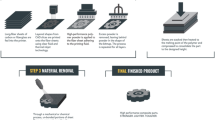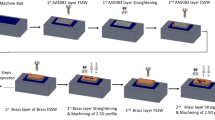Abstract
The gloss of plastic products is an important factor with which customers rapidly and directly decide the value of product. In general, these high-gloss plastic molded parts are produced through the injection molding of glass fiber-added plastic resin using a high temperature mold with the fine surfaces like glass. However, making the mold temperature higher causes the cooling time of injection molding longer, and the prolongation of cooling time leads to the extension of whole cycle of injection molding process. In order to resolve this problem, we developed a resin which makes the high-gloss injection modeling possible at low mold temperature by replacing conventional glass fiber filler with wollastonite filler. The tensile strength, flexural strain, impact strength, flow rate, gloss level and so on of the developed resin were tested with respect to the content of wollastonite. The results show that most of the properties except for the flow rate and gloss level are reduced in the newly developed resin. However, the decline in these properties was not enough to limit the use of new resins. In the gloss level test, as for the equal gloss of injection molded parts, the mold temperature for the developed resin was 30 °C lower than the mold temperature for the conventional resin. The difference of gloss between two injection molded parts using two different resins has been confirmed from the surface inspection of injection molded parts by SEM (scanning electron microscope).
Similar content being viewed by others
References
Y. W. Park, G. S. Lee and J. S. Kwak, A study on compound contents for plastic injection molding products of metallic resin pigment, Journal of Mechanical Science and Technology, 30 (12) (2016) 5673–5677.
T. A. Osswald, Polymer processing fundamentals, Hanser, Cincinnati, USA (1998).
G. Pötsch and M. Michaeli, Injection molding an introduction, Hanser, Cincinnati, USA (1995).
S. R. Han, J. R. Cho, S. K. Beak, J. A. Hong and Y. S. Lee, Numerical and experimental studies of injection compression molding process for thick plastic gas valve stem, The International Journal of Advanced Manufacturing Technology, 89 (1-4) (2017) 651–660.
A. Kumre, R. S. Rana and R. Purohit, A review on mechanical property of sisal glass fiber reinforced polymer composites, Materialstoday: Proceedings, 4 (2) Part A (2017) 3466–3476.
G. Menning and K. Stoeckhert, Mold-making handbook, 3rd Ed., Hanser, Cincinnati, USA (2013).
A. Soltani, R. Hosseinpourpia, S. Adamopoulos, H. R. Taghiyari and E. Ghaffari, Effects of heat-treatment and nano-wollastonite impregnation on fire properties of solid wood, BioResources, 11 (4) (2017) 8953–8967.
S. Azeena, N. Subhapradha, N. Selvamurugan, S. Narayan, N. Srinivasan, R. Murugesan, T. W. Chung and A. Moorthi, Antibacterial activity of agricultural waste derived wollastonite doped with copper for bone tissue engineering, Materials Science and Engineering: C, 71 (2017) 1156–1165.
T. Singh, A. Tiwari, A. Patnaik, R. Chauhan and S. Ali, Influence of wollastonite shape and amount on triboperformance of non-asbestos organic brake friction composites, Wear, 386–387 (2017) 157–164.
M. A. Wahab, I. A. Latif, M. Kohail and A. Almasry, The use of wollastonite to enhance the mechanical properties of mortar mixes, Construction and Building Materials, 152 (2017) 304–309.
T. Singh, A. Patnaik, R. Chauhan and A. Rishiraj, Assessment of braking performance of lapinus–wollastonite fibre reinforced friction composite materials, Journal of King Saud University Engineering Sciences, 29 (2) (2017) 183–190.
A. Chatterjee, P. Khobragade, S. Mishra and J. Naik, Advanced microemulsion synthesis and characterization of wollastonite (CaSiO3)/polystyrene one-dimensional nanorods with core–shell structures, Particuology, 30 (2017) 118–128.
Author information
Authors and Affiliations
Corresponding author
Additional information
Recommended by Associate Editor Hak-Sung Kim
Jae-hoon Lee graduated from the Graduate School of Mold Convergence, Kongju National University in 2018 and currently works at Samyang Tech Center. His research interests include injection molding, mold design.
Seong-Ryeol Han earned Ph.D. in Mechanical Engineering at Pukyong National University in 2007. He now works as an Associate Professor at Kongju National University. His research interests include injection molding, mold design and injection molding CAE.
Rights and permissions
About this article
Cite this article
Lee, J., Cho, J. & Han, S. Development of high gloss plastic for injection molding by utilizing wollastonite(CaSiO3) and talc fillers. J Mech Sci Technol 32, 3645–3652 (2018). https://doi.org/10.1007/s12206-018-0716-5
Received:
Revised:
Accepted:
Published:
Issue Date:
DOI: https://doi.org/10.1007/s12206-018-0716-5




